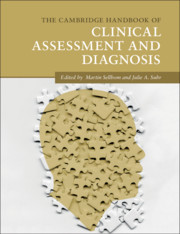Book contents
- The Cambridge Handbook of Clinical Assessment and Diagnosis
- The Cambridge Handbook of Clinical Assessment and Diagnosis
- Copyright page
- Contents
- Figures
- Tables
- Contributors
- Acknowledgments
- 1 Introduction to the Handbook of Clinical Assessment and Diagnosis
- Part I General Issues in Clinical Assessment and Diagnosis
- Part II Specific Clinical Assessment Methods
- Part III Assessment and Diagnosis of Specific Mental Disorders
- Part IV Clinical Assessment in Specific Settings
- 32 Screening and Assessment in Integrated Primary Care Settings
- 33 Psychological Assessment in Forensic Settings
- 34 Assessment Issues within Neuropsychological Settings
- 35 Assessment in Educational Settings
- Index
- References
34 - Assessment Issues within Neuropsychological Settings
from Part IV - Clinical Assessment in Specific Settings
Published online by Cambridge University Press: 06 December 2019
- The Cambridge Handbook of Clinical Assessment and Diagnosis
- The Cambridge Handbook of Clinical Assessment and Diagnosis
- Copyright page
- Contents
- Figures
- Tables
- Contributors
- Acknowledgments
- 1 Introduction to the Handbook of Clinical Assessment and Diagnosis
- Part I General Issues in Clinical Assessment and Diagnosis
- Part II Specific Clinical Assessment Methods
- Part III Assessment and Diagnosis of Specific Mental Disorders
- Part IV Clinical Assessment in Specific Settings
- 32 Screening and Assessment in Integrated Primary Care Settings
- 33 Psychological Assessment in Forensic Settings
- 34 Assessment Issues within Neuropsychological Settings
- 35 Assessment in Educational Settings
- Index
- References
Summary
The practice of neuropsychology offers a unique yet multidimensional approach to clinical assessment, with its emphasis on the Bio-Psycho-Social Model. This chapter addresses a variety of issues that are relevant in our field, beginning with a discussion of the recommended model of training in neuropsychology and purposes of neuropsychological assessment. To give the reader a sense of the current context of neuropsychological assessment, we also describe the most typical work settings and specific issues in each, as well as populations seen and instruments used in our field. We then discuss some aspects of the assessment process that neuropsychologists consider, in addition to common challenges of our clinical and research practice, such as the assessment of practice effects, effort, individuals from diverse cultural and linguistic backgrounds, and general validity issues. We end this chapter with a brief discussion of the future of neuropsychological assessment and how technology may play a key role in shaping the activities and settings of our practice.
Keywords
- Type
- Chapter
- Information
- The Cambridge Handbook of Clinical Assessment and Diagnosis , pp. 472 - 484Publisher: Cambridge University PressPrint publication year: 2019



